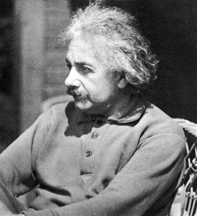![]()

|
Can You Believe It? There is a crater on the Moon named after Albert Einstein.
|
Albert Einstein was born in 1879 in Ulm, Germany. He was the first child born to Hermann and Pauline Einstein. Though he attended school as a young boy, he also received instruction at home on Judaism and violin. By the age of twelve he had taught himself geometry. At the age of sixteen he failed an exam in order to qualify to train as an electrical engineer. He remained in school and developed a new plan for his future. Einstein decided to study math and physics so he could become a teacher. Einstein thought he would be good at this because he could think mathematically and abstractly while lacking imagination and practicality. In 1896 he renounced his German citizenship. He was not a citizen of any country until 1901 when he became a citizen of Switzerland. In 1900 he graduated as a teacher of math and physics. His teachers did not think very highly of him though so he had difficulty being recommended for a job at a university. In 1901 he took a job as a temporary high school teacher and married Mileva Maritsch. The couple had two sons prior to divorcing. Einstein later married his cousin Elsa Einstein. From 1902 through 1909, Einstein worked in a patent office in Bern, Switzerland. While working in the patent office he published many papers on theoretical physics. He earned a Ph.D. in 1905.
In 1905 Einstein wrote a paper on what is now known as the special theory of relativity. This paper contained two hypotheses. The first stated that the laws of physics had to have the same form in any frame of reference. The second hypothesis stated that the speed of light was a constant. Later that year Einstein also showed how mass and energy were equivalent. Following an impressive few years of work, Einstein became a lecturer at the University of Bern. In 1909 he finally got a post at a university when he became a faculty member at the University of Zurich. In 1911 Einstein taught at Carl-Ferdinand University in Prague. The following year he returned to Germany to continue his work. In 1916 Einstein published his general theory of relativity. This theory linked gravitation, acceleration and the four dimensional space-time. With this theory he was able to account for the variations in the orbital motions of the planets. He also predicted that starlight in the vicinity of a massive object such as the Sun could be bent. This was confirmed in 1919 during a solar eclipse. This further increased the adulation with which the press viewed Einstein. He won the Nobel Prize for Physics in 1921 for his work on the photoelectric effect. This work proposed that light be considered as consisting of particles called photons. Einstein further proposed that the energy the photon contains is proportional to the frequency of the radiation.
Einstein was not only a scientist, but also a social activist and a humanitarian. He spoke out against the German involvement in World War I. In 1920 a demonstration interrupted a lecture given by Einstein in Berlin. There was also growing criticism of his work by certain Germans. Einstein felt the disruptions and criticisms were occurring because he was Jewish. Einstein traveled the world lecturing and raising funds for a planned Hebrew University in Jerusalem. His hectic lifestyle led to a physical collapse in 1928. By 1930 he was once again travelling the world, especially the United States. On one of these visits, he was offered a post with the Institute for Advanced Study near Princeton University. Einstein accepted, believing that he would spend seven months of the year in Munich and five months of the year in the United States. In December of 1932 he left for the United States. A month after his departure the Nazis assumed control of Germany. Einstein never returned to Germany. In 1935 Einstein was granted permanent residency in the United States and became a citizen in 1940. In 1944 he hand wrote his 1905 theory on relativity and allowed it to be auctioned. It sold for six million dollars, which he donated to the effort to win World War II. The work resides in the Library of Congress in Washington, D.C. By 1949 Einstein was in failing health. His health was so bad that when offered the presidency of Israel in 1952 he had to decline it. In 1955, one week prior to his death, he agreed to have his name appear on a manifesto calling for the end to nuclear weapons. He died in April of 1955 in Princeton, New Jersey. Einstein was cremated and his ashes were spread at an undisclosed location.
A QuestionFor what work was Albert Einstein awarded the Nobel Prize? |
| Did you know? |
The Answer |
The StarChild site is a service of the High Energy Astrophysics Science Archive Research Center (HEASARC), within the Astrophysics Science Division (ASD) at NASA/ GSFC.
StarChild Authors: The StarChild Team
StarChild Graphics & Music: Acknowledgments
StarChild Project Leader: Dr. Laura A.
Whitlock
Curator:
Responsible NASA Official: